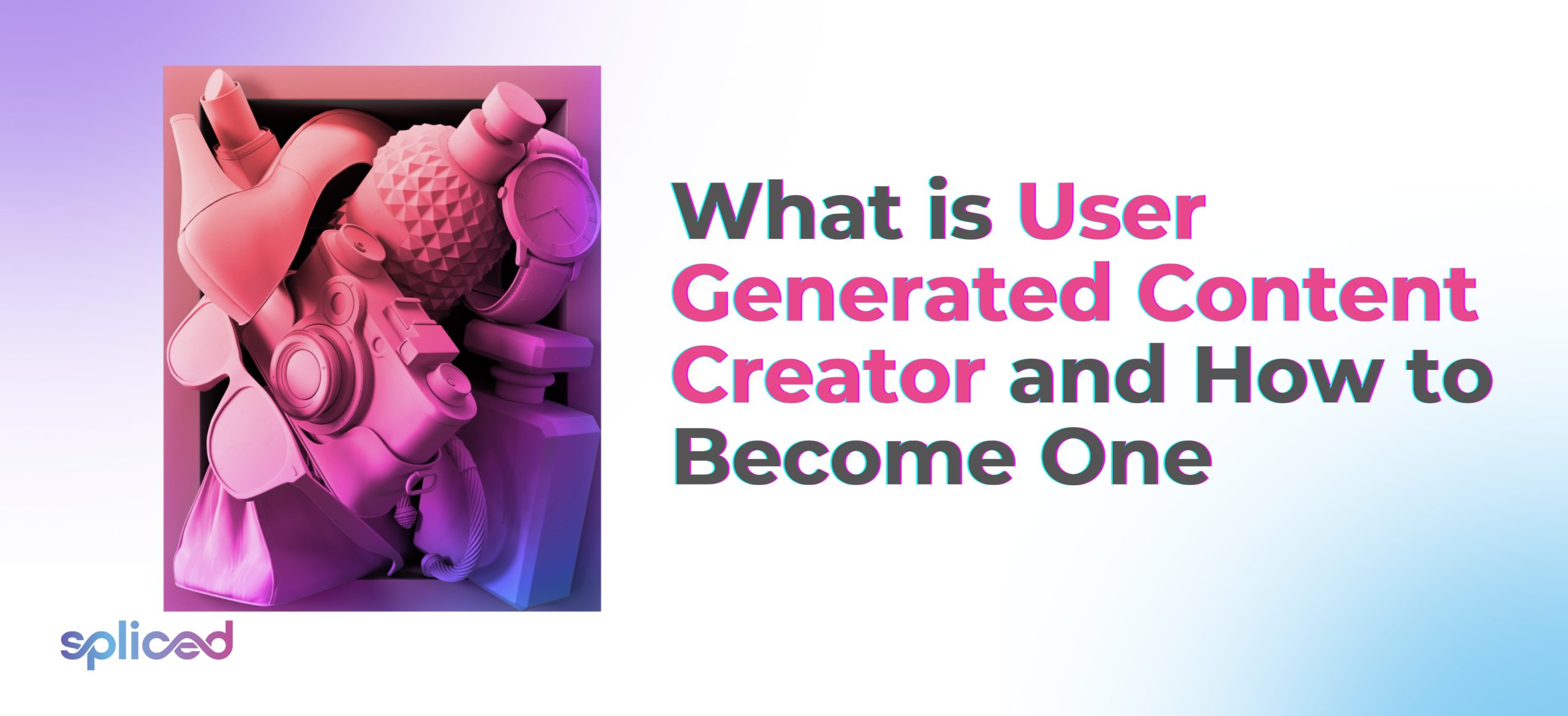A User Generated Content Creator, known as a “UGC Creator,” is a person who generates content within online platforms or communities where users are the primary contributors. User Generated Content Creators’ content is produced for various reasons, such as for community involvement, enjoyment, or personal expression, and it comes in a broad range of forms, including text, photographs, videos, and other multimedia.
Participating actively in online communities where user-generated material is recognized and promoted is necessary to become a “UGC Creator.” It includes websites with a strong sense of community, such as social networking platforms, forums, and blogs. Finding one’s niche and finding communities to share material with are the first steps to becoming a “UGC Creator.” It includes signing up for certain internet forums, participating in pertinent debates, and producing material that appeals to the neighborhood’s interests.
People with a talent for creating exciting and relevant material find possibilities in various “User-Generated Content Jobs” across businesses that value genuine and community-driven content production as UGC Creator positions continue to gain relevance. The pattern emphasizes the substantial influence and effect of “User-Generated Content” on the digital environment.
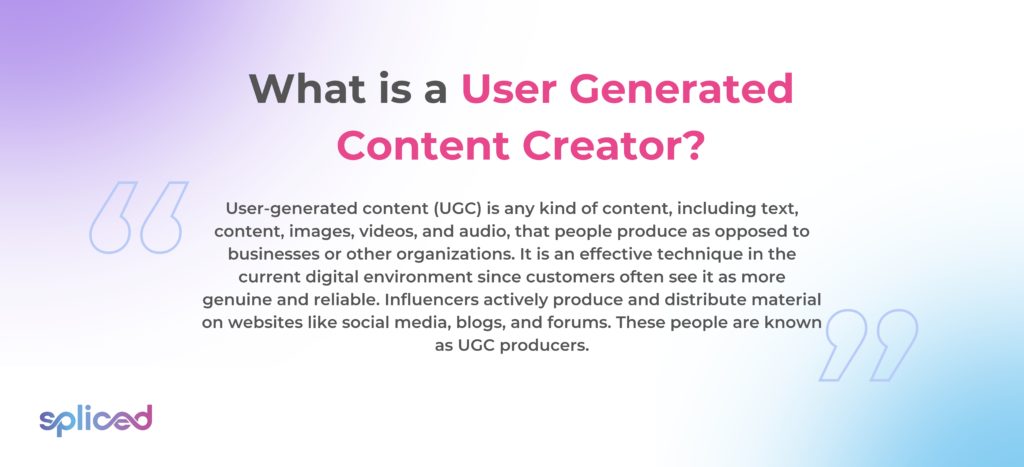
What is User Generated Content?
User-generated content (UGC) is any kind of content, including text, content, images, videos, and audio, that people produce as opposed to businesses or other organizations. It is an effective technique in the current digital environment since customers often see it as more genuine and reliable. Influencers actively produce and distribute material on websites like social media, blogs, and forums. These people are known as UGC producers. They are essential in amplifying and spreading UGC. These artists have devoted fan bases and are often seen as relatable individuals, which makes their work very powerful. A UGC creator curates and shares user-generated material, serving as a middleman between the content providers and their audience. It is what people mean when they ask, “What is a UGC creator?”
“UGC” refers to a broad range of material from users rather than brands. It includes ratings and reviews of the products, user comments, social media postings, blog articles, and even original works of art like fan art or remixes. People who ask, “What is UGC?” want to know more about the important type of material that has changed how companies connect with their customers. Brands often use UGC to foster trust, interact with their audience, and learn important things about consumers’ behavior. It is a dynamic and engaging marketing that encourages a feeling of belonging and community.
User-generated content (UGC) and its authors are crucial in modern digital marketing tactics. They represent the move towards more community-driven and genuine content development. Businesses take advantage of the enormous potential of the material for developing deep relationships with their audience by understanding what UGC is and the relevance of User Generated Content producers.
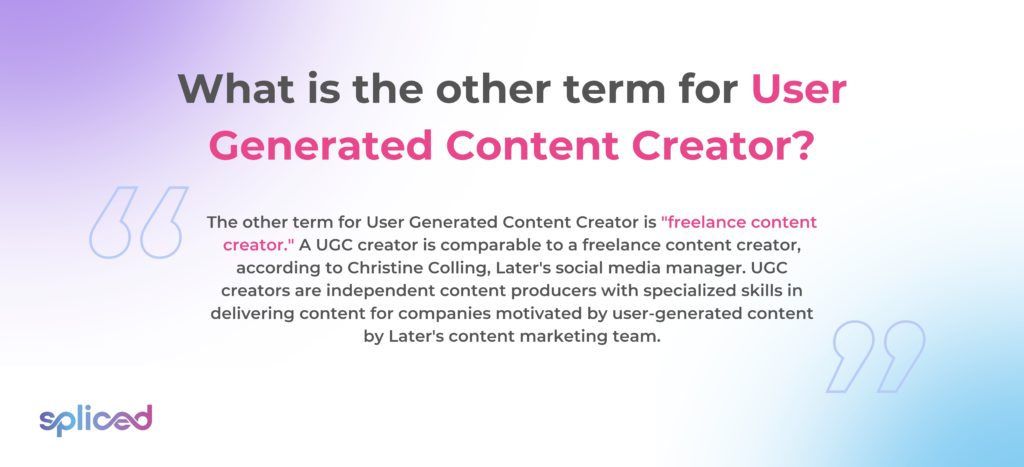
What is the other term for User Generated Content Creator?
The other term for User Generated Content Creator is “freelance content creator.” A UGC creator is comparable to a freelance content creator, according to Christine Colling, Later’s social media manager. UGC creators are independent content producers with specialized skills in delivering content for companies motivated by user-generated content by Later’s content marketing team. It contains diverse media types, such as images and videos. UGC creators and independent content producers are used interchangeably, highlighting their skill in making material that aligns with the user-generated aesthetic for brand advertisement.
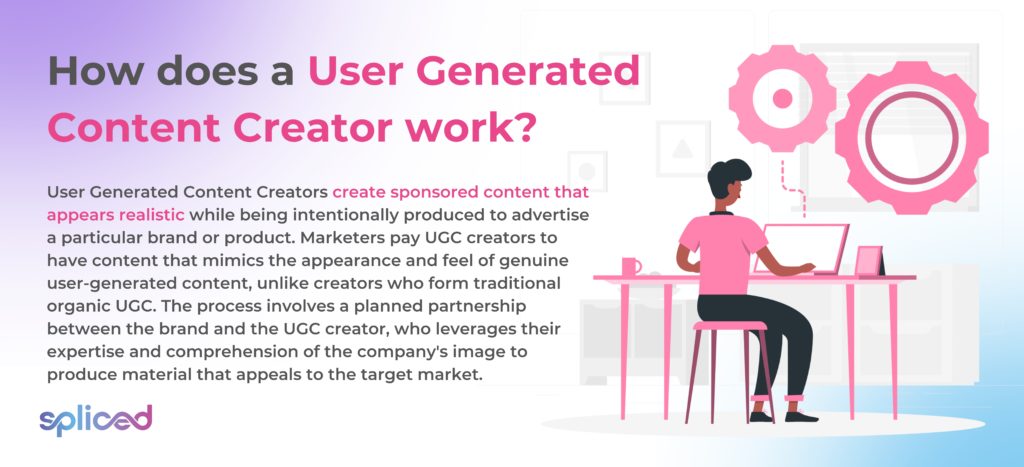
How does a User Generated Content Creator work?
User Generated Content Creators create sponsored content that appears realistic while being intentionally produced to advertise a particular brand or product. Marketers pay UGC creators to have content that mimics the appearance and feel of genuine user-generated content, unlike creators who form traditional organic UGC. The process involves a planned partnership between the brand and the UGC creator, who leverages their expertise and comprehension of the company’s image to produce material that appeals to the target market. The material is designed to effortlessly mix with other user-generated content on social media sites, grabbing viewers’ attention and highlighting the brand’s products. UGC producers play a crucial role in linking the gap between genuine user-generated material and the commercial goals of organizations.
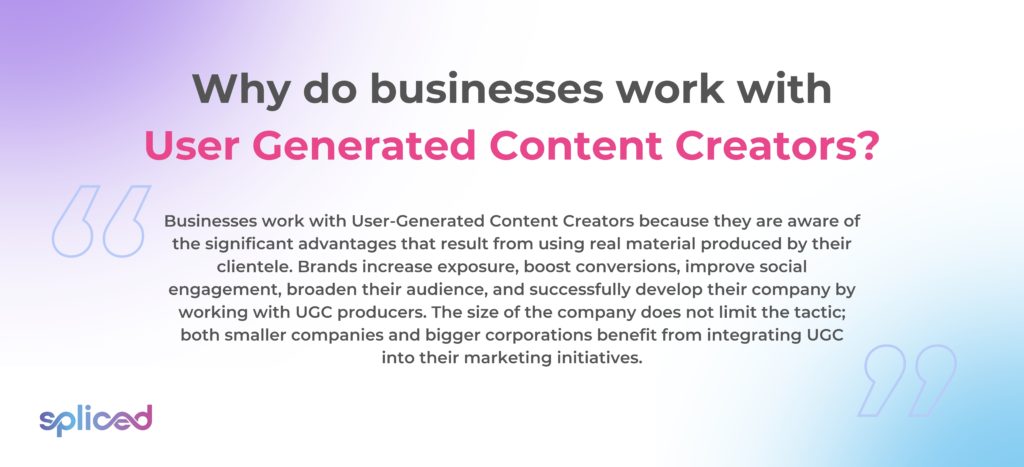
Why do businesses work with User Generated Content Creators?
Businesses work with User-Generated Content Creators because they know the significant advantages of using real material produced by their clientele. Brands increase exposure, boost conversions, improve social engagement, broaden their audience, and successfully develop their company by working with UGC producers. The company’s size does not limit the tactic; smaller companies and bigger corporations benefit from integrating UGC into their marketing initiatives.
One of the main reasons businesses pay UGC content producers is to take advantage of the rare chance for consumers to actively engage in brand development rather than just watching from the sidelines. Individuals have a strong feeling of brand loyalty and affinity as a result of their engagement because it makes them feel like they belong and have a role in the world. They become active participants in a brand’s community by producing UGC.
UGC is a starting point for deep dialogues between a company and its customers. The increased degree of contact fosters a more active and connected community. Businesses establish deeper ties and boost brand loyalty by distributing material their audience creates. Businesses and UGC artists working together get real results in marketing data, build a closer connection with customers, and keep them coming back, which is good for the brand’s long-term growth and success.
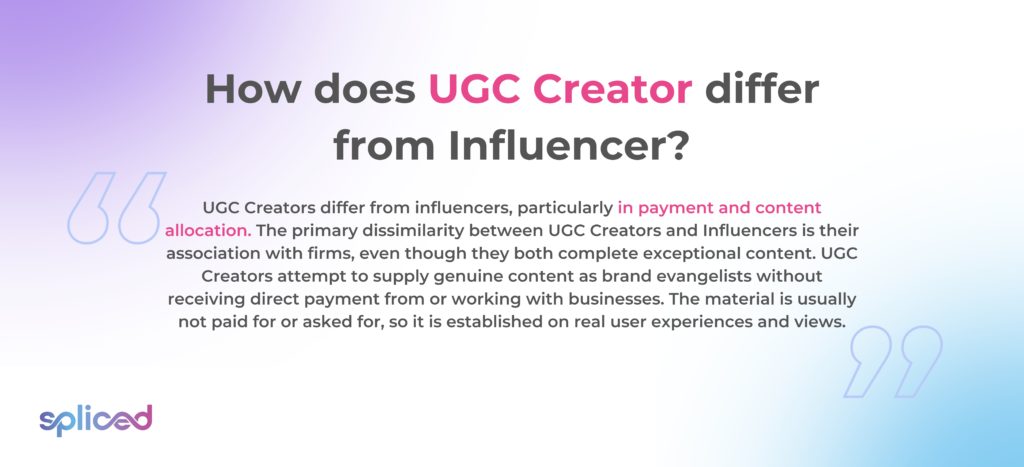
How does UGC Creator differ from Influencer?
UGC Creators differ from influencers, particularly in payment and content allocation. The primary dissimilarity between UGC Creators and Influencers is their association with firms, even though they both complete exceptional content. UGC Creators attempt to supply genuine content as brand evangelists without receiving direct payment from or working with businesses. The material is usually not paid for or asked for, so it is established on real user experiences and views.
UGC Creators, on the other hand, are paid to supply distinct movies or photographs that include items and are meant to be shared via the brand’s marketing channels. UGC Creators pay brands in return for their work, which is frequently $250 for a 60-second video but varies. The raw film is repurposed, and marketers get full rights to the material for future uses. Creators of UGC do not naturally disseminate the content on their social accounts; instead, they provide it to the brand for reposting on the brand’s marketing channels.
Influencers get paid to make content about goods and share it on their social media accounts. The quantity of Stories, TikToks, or Instagram posts they post for the company is commonly specified in their contracts. Brands talk to celebrities about getting content rights, but not all do. The main distinction is that Influencers are compensated for generating material that they exclusively disseminate on their marketing channels, while UGC Creators are remunerated for creating content that businesses solely spread. The distinction emphasizes companies’ multiple techniques when utilizing user-generated content and influencer marketing.
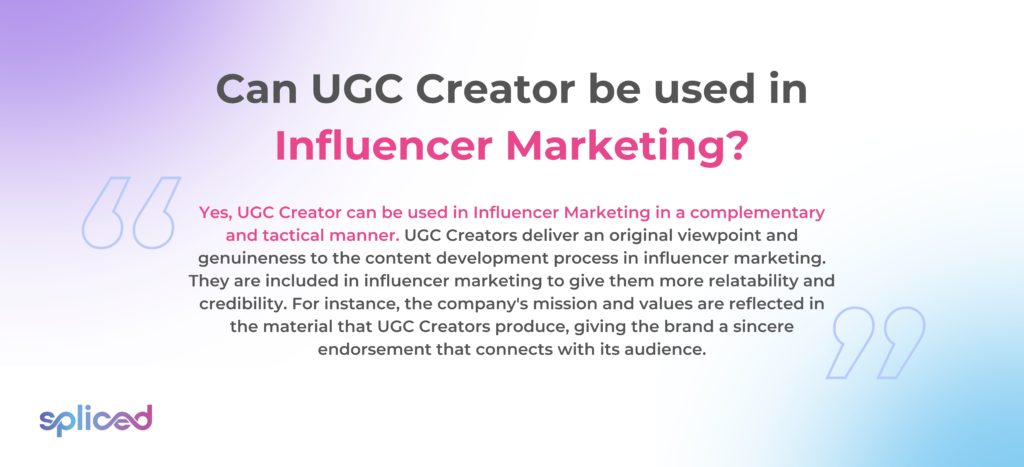
Can UGC Creator be used in Influencer Marketing?
Yes, UGC Creator can be used in Influencer Marketing in a complementary and tactical manner. UGC Creators deliver an original viewpoint and genuineness to the content development process in influencer marketing. They are included in influencer marketing to give them more relatability and credibility. For instance, the company’s mission and values are reflected in the material that UGC Creators produce, giving the brand a sincere endorsement that connects with its audience. The collaborative strategy enables marketers to benefit from the achievement and influence of established influencers while using the creative abilities of UGC Creators. Brands develop effective campaigns that draw on the authenticity of user-generated content and maximize the broad audience reach of influencers by combining both advantages. The hybrid strategy increases the effectiveness of Influencer Marketing initiatives and provides customers with more memorable and genuine brand experiences.
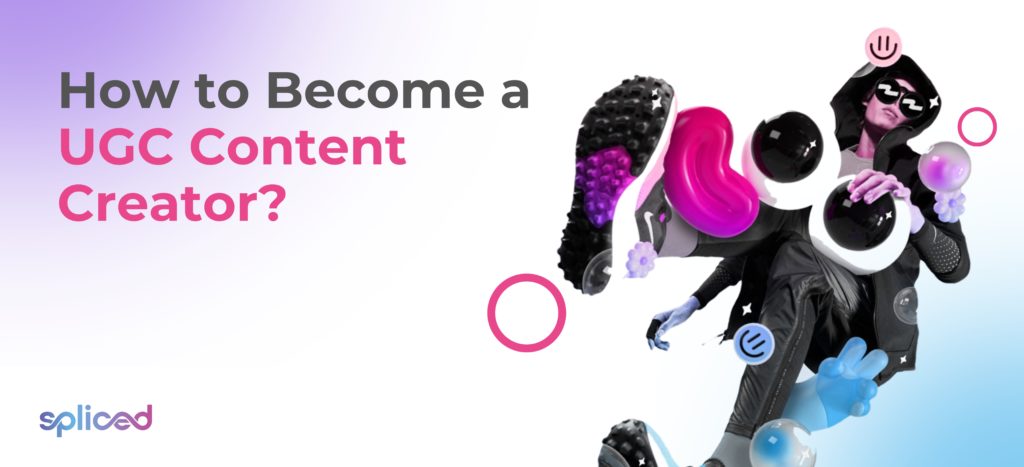
How to Become a UGC Content Creator?
To become a UGC Content Creator, the step-by-step guide is listed below.
- Step 1: Determine the kinds of brands to collaborate with. It entails coordinating the brand’s values, interests, and preferred content category. It guarantees content creation’s legitimacy, laying the groundwork for fruitful collaboration. Think about elements like target market, product relevance, and brand ethos. The quality and value of the content are improved by a brand that fits the content properly. Content production value is considerably increased by purchasing crucial filming equipment, such as a high-quality camera, a sturdy tripod, suitable lighting, and a strong microphone. It makes the material more attractive to companies and the audience.
- Step 2: Arrange your filming setup. It entails deciding on a well-lit area with a suitable background and keeping the recording gear steady. The audio must get attention, with an external microphone and a background noise check being advised. The basis for creating excellent, interesting material is carefully arranging the filming equipment. It is essential in creating user-generated content because it improves the material’s credibility and professionalism, ensuring that it effectively conveys the intended message and resonates with the audience.
- Step 3: Train in creating User Generated Content. It entails knowing how to use production software and equipment, taking aesthetically attractive, artfully produced images or movies, and comprehending the craft of narrative. Editing abilities are important for improving overall quality. Be familiar with social media platforms and adapt material to the tastes of certain audiences. Being aware of industry trends is crucial since content development is continually changing. The education lays the groundwork for a successful career as a UGC content producer who creates engaging content that successfully furthers brand goals.
- Step 4: Enhance your editing abilities. UGC developers must develop their editing abilities. The quality of the material is improved by mastering post-production methods, such as fine-tuning editing style and using programs like Adobe Premiere Pro or Final Cut Pro. It entails seamless clip integration, effects application, color grading, and sound design for a clean and expert finish. Developing writing abilities turns unorganized, raw videos into aesthetically beautiful material with depth and coherence for a more interesting watching experience. These abilities set UGC creators apart and show commitment and attention to detail, which makes their work more valuable and shareable in the cutthroat digital market.
- Step 5: Create your UGC portfolio. It involves curating standout user-generated content that showcases versatility, style, and proficiency. Showcase the ability to produce compelling content across media by including a variety of formats, such as photographs, videos, and written postings. The portfolio must demonstrate familiarity with various platforms and their corresponding audiences. Ensure the navigation is simple and user-friendly, and provide succinct explanations for each component. An organized portfolio demonstrates professionalism and devotion while acting as a concrete representation of the abilities and aiding companies and prospective partners in determining fit with their goals.
- Step 6: Propose your services to brands. It entails aggressively seeking out possible partners and demonstrating competence in developing real and compelling content. Start by undertaking in-depth research to find businesses that share the beliefs and content ethos. Create a persuasive elevator pitch highlighting the unique approach to user-generated content and its advantages for the brand’s marketing plan. Emphasize the knowledge of their intended audience and how the material appeals to them. It begins the cooperation between the brand and the UGC Content Creator, demonstrating initiative and skill. It is committed to boosting the brand’s marketing initiatives and building the basis for enduring connections. The proactive approach results in profitable alliances and a successful career as a UGC Content Creator by displaying originality and the capacity to match the brand’s image.
- Step 7: Discover chances on UGC creator platforms. It’s important to examine sites like Instagram, TikTok, and YouTube, as well as niche influencer marketing platforms like AspireIQ, Traackr, and Upfluence. Create captivating profiles highlighting one’s uniqueness and content development abilities, and refresh the portfolio with top-notch examples of the work. Increase the chances of getting found by businesses seeking UGC producers by participating actively in discussions and networking events on these sites. Using these channels efficiently increases the visibility and prospects for partnerships as an aspiring UGC Content Creator.
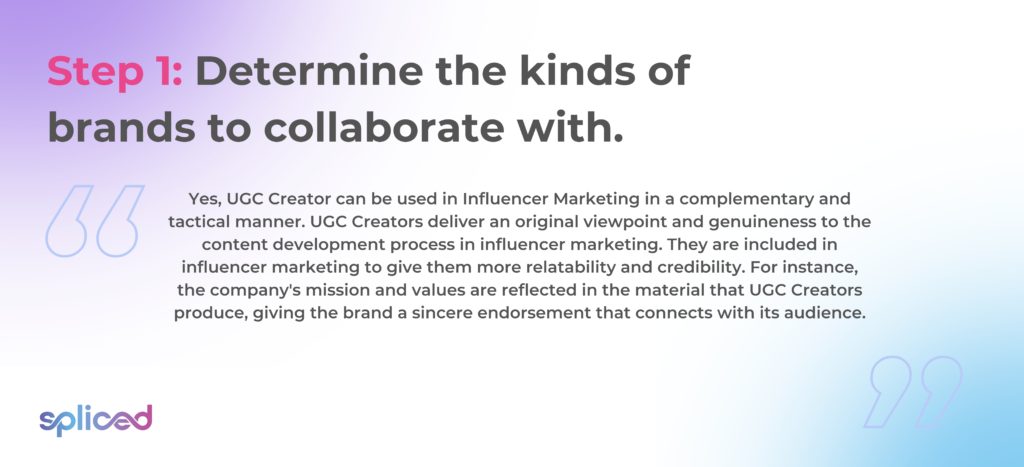
1. Step 1: Determine the kinds of brands to collaborate with
Determine the kinds of brands to collaborate with by carefully choosing and identifying the brands that match the beliefs, hobbies, and preferred kind of content. Focusing on businesses that relate to the audience and specialty is essential since it assures the authenticity of the content development process. It lays the groundwork for real and powerful cooperation. It is a crucial stage since it determines the overall direction of the content development process, affecting the material’s quality and usefulness.
Consider elements like brand ethos, product relevancy, and target demographic when determining the kinds of brands to cooperate with. Aspiring UGC Creator must find businesses that provide products or services that really interest them and their target market. Collaborating with athleisure or health food manufacturers, for instance, makes sense if the content focuses on fitness and wellbeing. Consider companies with comparable ideals or causes since it results in more relevant and real content.
Making high-quality footage requires a must-need filming setup and the use of the appropriate tools. A necessary setup includes a high-quality camera or smartphone, a firm tripod or gimbal for steady shots, enough illumination (natural or artificial), and a decent microphone for crystal-clear audio recording. These components dramatically raise the production value of the material, making it more appealing to companies and the audience.
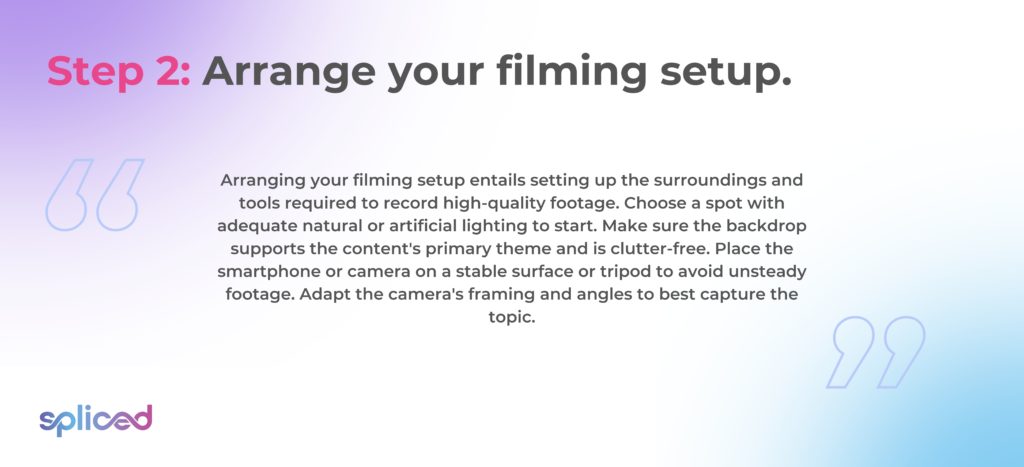
2. Step 2: Arrange your filming setup
Arranging your filming setup entails setting up the surroundings and tools required to record high-quality footage. Choose a spot with adequate natural or artificial lighting to start. Make sure the backdrop supports the content’s primary theme and is clutter-free. Place the smartphone or camera on a stable surface or tripod to avoid unsteady footage. Adapt the camera’s framing and angles to best capture the topic.
Take into account the audio quality as well. Using an extra microphone is recommended to get good sound. Check the audio levels to ensure no distorted or unwelcome background noises. Ensure the camera is level and the subject is appropriately positioned in the frame by paying close attention to the little things. A polished and eye-catching basis for the material is produced by precisely planning the filming equipment.
Arranging the filming setup is one of the most important steps in becoming a UGC Content Creator. A well-organized setting creates the ideal environment for creating high-quality, aesthetically attractive, and engaging material. The material becomes more credible and professional, enhancing its attractiveness to the audience. The phase ensures the material is clear, well-framed, and successfully expresses the intended message. The foundation for producing an engaging user-generated video that connects with the audience is a well-planned filming arrangement.
The stage is crucial in “how to create UGC,” as it is the foundation for generating material that stands out and draws the audience in. A well-planned filming setup improves the overall quality and impact of the user-generated material, increasing its likelihood of driving interaction and meeting the content production objectives.
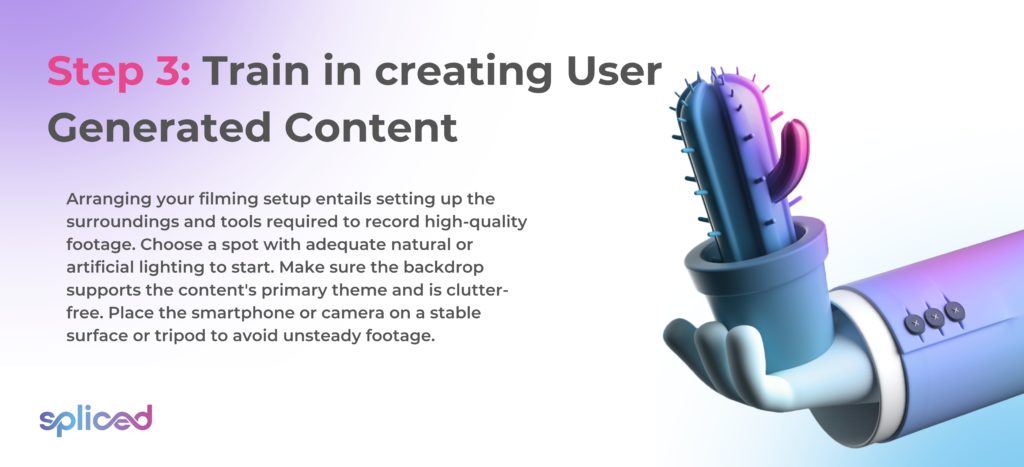
3. Step 3: Train in creating User Generated Content
Training in creating User Generated Content entails improving the talents in creating content that is appealing to viewers and consistent with brand messaging. Learn about the different software and tools available for content production to start. Learn to take high-quality pictures or films that are attractive to the eye, well-lit, and well-composed. Learn the craft of storytelling and how to use the material to successfully deliver messages. Improve the general quality of the work by learning how to edit them.
Understanding the subtleties of social media networks and their unique capabilities for content sharing is crucial. Customizing the material for optimal effect depends on the ability to comprehend the preferences and habits of the target audience on various platforms. Keep up with the most recent developments in content production since it is a dynamic industry that changes quickly.
Training is critical in developing User Generated Content. It serves as the cornerstone of the responsibilities as a creator of UGC. The course teaches aspiring UGC creators how to create content that captivates viewers and blends with the brand’s image. It enables authentic and effective message delivery, a crucial aspect of UGC. The aspiring creator is well-prepared to begin on the path of becoming a skilled UGC material creator, capable of generating engaging material that corresponds with brand goals if they get the necessary training.
Learning the steps of Creating User Generated Content is essential to becoming a UGC content creator. Creators develop real and engaging content that connects with consumers and successfully promotes the business after receiving training and improving their content production abilities. The phase establishes the groundwork for a successful career in UGC content development.
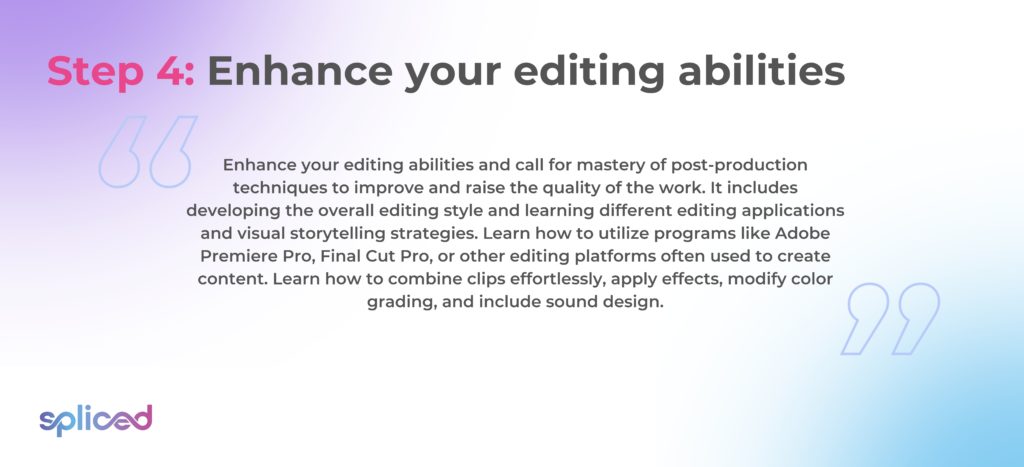
4. Step 4: Enhance your editing abilities
Enhance your editing abilities and call for mastery of post-production techniques to improve and raise the quality of the work. It includes developing the overall editing style and learning different editing applications and visual storytelling strategies. Learn how to utilize programs like Adobe Premiere Pro, Final Cut Pro, or other editing platforms often used to create content. Learn how to combine clips effortlessly, apply effects, modify color grading, and include sound design. It guarantees the material has a polished and professional appearance, increasing its readability and attractiveness.
Improving the writing skills is very important when it comes to making UGC material. Use it to turn unprocessed video into aesthetically appealing and well-organized material. A talented editor improves the videos’ overall watching experience by adding depth, emotion, and coherence. It distinguishes an individual as a content creator and increases the likelihood that their content is shared and valued by a larger audience. Good editing shows that a UGC creator cares about the business or product they’re promoting by giving the impression of skill and attention to detail. Developing editing abilities is ultimately a crucial part of producing UGC that stands out in a crowded digital market.
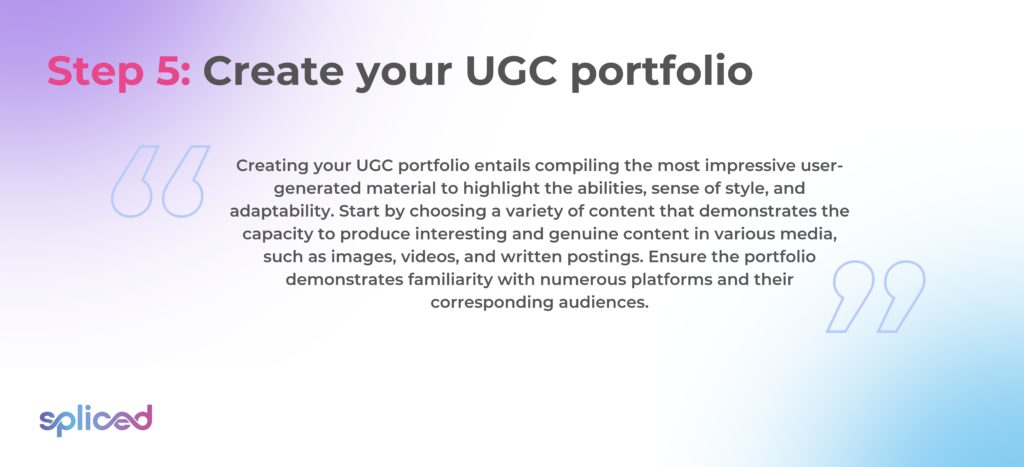
5. Step 5: Create your UGC portfolio
Creating your UGC portfolio entails compiling the most impressive user-generated material to highlight the abilities, sense of style, and adaptability. Start by choosing a variety of content that demonstrates the capacity to produce interesting and genuine content in various media, such as images, videos, and written postings. Ensure the portfolio demonstrates familiarity with numerous platforms and their corresponding audiences. Set up the portfolio in a straightforward and user-friendly way so that prospective clients or companies traverse it with ease and enjoy the work. A quick explanation or background for each component provides insightful information about the thinking and approach.
The creation of a UGC portfolio is essential. It is a visible and concrete illustration of the talents as a creator of user-generated content. Brands and prospective partners often use portfolios to see if the style and content match their goals and objectives. A well-organized portfolio shows professionalism and devotion, which win over potential clients. It’s a great way to show off diversity and adaptability by displaying the ability to write for several audiences. Securing partnerships and opportunities in the competitive world of content creation requires a compelling UGC portfolio.
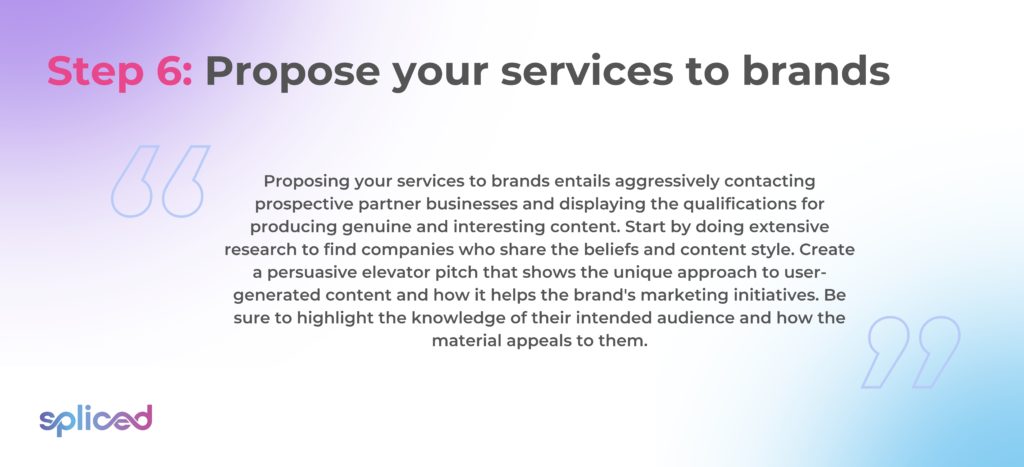
6. Step 6: Propose your services to brands
Proposing your services to brands entails aggressively contacting prospective partner businesses and displaying the qualifications for producing genuine and interesting content. Start by doing extensive research to find companies who share the beliefs and content style. Create a persuasive elevator pitch that shows the unique approach to user-generated content and how it helps the brand’s marketing initiatives. Be sure to highlight the knowledge of their intended audience and how the material appeals to them. The ideas must reflect the dedication to enhancing the marketing plan for the brand by being formal, succinct, and detailed.
The step is very important because it starts the process of working together between the brand and an individual as a UGC Content Creator. Proactively offering the services is a great way to demonstrate initiative and set oneself apart as a competent writer. The action shows the effort and excitement in supporting their marketing activities, which is essential in developing long-term relationships with businesses. It lets the creator show off their imagination and ability to make content that fits in perfectly with the brand’s image, which leads to good partnerships and a successful job as a UGC Content Creator.
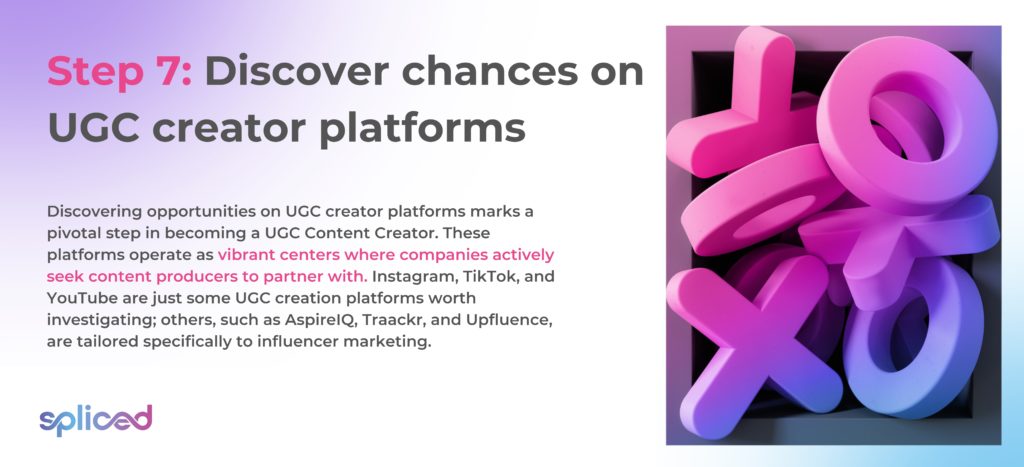
7. Step 7: Discover chances on UGC creator platforms
Discovering opportunities on UGC creator platforms marks a pivotal step in becoming a UGC Content Creator. These platforms operate as vibrant centers where companies actively seek content producers to partner with. Instagram, TikTok, and YouTube are just some UGC creation platforms worth investigating; others, such as AspireIQ, Traackr, and Upfluence, are tailored specifically to influencer marketing. Create engaging profiles on these networks that highlight individuality, hobbies, and content production skills. Update the portfolio regularly with high-quality samples of the work, and make sure the contact information is easily accessible for future partnerships. Engage in conversations and networking events on these sites to raise the profile and the chances of getting found by businesses looking for UGC producers.
Discovering chances on UGC creator platforms is essential since it emphasizes the value of actively looking for partnership opportunities. Platforms for UGC producers provide a centralized setting for connecting with companies, making them an essential route for establishing collaborations and growing the audience. There are good chances that UGS creator is going to miss out on working with brands and showing off their content-generation skills if they don’t use and explore these platforms.
Different platforms are designed to help UGC producers and influencers work together. Content producers choose Instagram because of its large user base and aesthetic focus. The short-form video app TikTok has quickly established itself as a powerful platform for producers. Longer-form material is found on YouTube, which has a strong community of content producers. Influencer marketing platforms such as AspireIQ, Traackr, and Upfluence provide curated places for businesses to identify and interact with UGC producers for focused campaigns. Aspiring UGC Content Creators greatly increase their exposure and prospects for cooperation by effectively using these platforms.
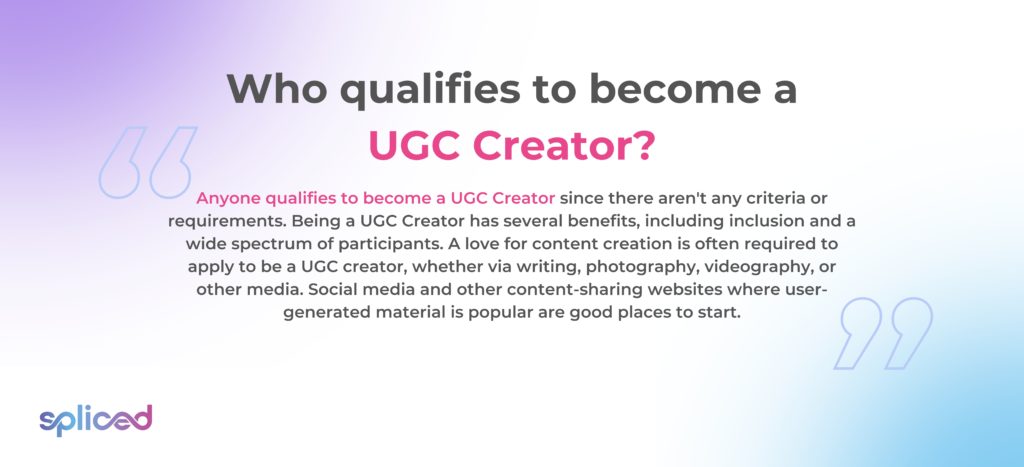
Who qualifies to become a UGC Creator?
Anyone qualifies to become a UGC Creator since there aren’t any criteria or requirements. Being a UGC Creator has several benefits, including inclusion and a wide spectrum of participants. A love for content creation is often required to apply to be a UGC creator, whether via writing, photography, videography, or other media. Social media and other content-sharing websites where user-generated material is popular are good places to start. The most important thing is to be real, creative, and interested in the things or themes one wants to write about. UGC Creators are regular individuals eager to share their knowledge, talent, and experiences with a larger audience.
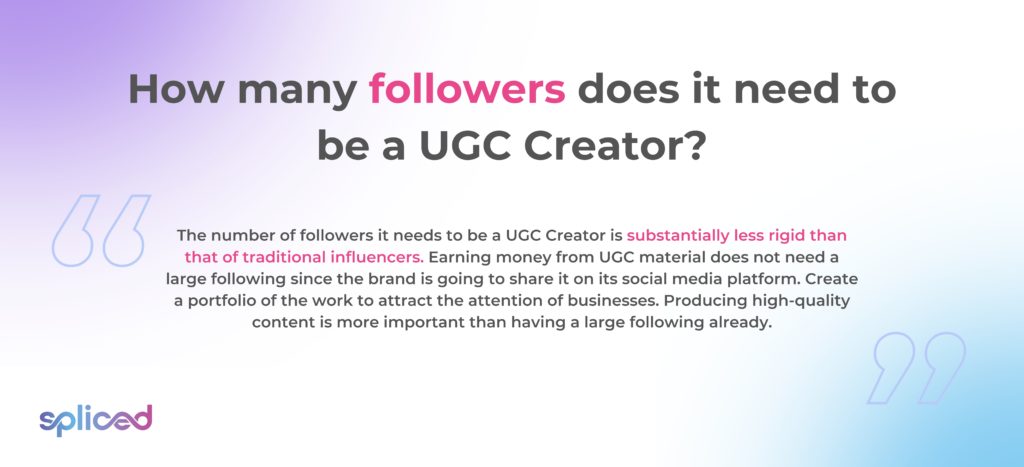
How many followers does it need to be a UGC Creator?
The number of followers it needs to be a UGC Creator is substantially less rigid than that of traditional influencers. In fact, you can even have 0 followers across your social media channels to be a UGC crator. Earning money from UGC material does not need a large following since the brand is going to share it on its social media platform. Create a portfolio of the work to attract the attention of businesses. Producing high-quality content is more important than having a large following already.
UGC producers do not need a huge audience, unlike influencers, who often need one before collaborating with businesses. They operate more like independent influencers, concentrating on producing UGC-inspired material that businesses buy and then broadcast on their own channels. Providing real and interesting material that appeals to a certain target audience is more important to becoming a UGC Creator than having many followers. The accessibility opens up UGC Creator jobs to a broader spectrum of content producers independent of their follower numbers.
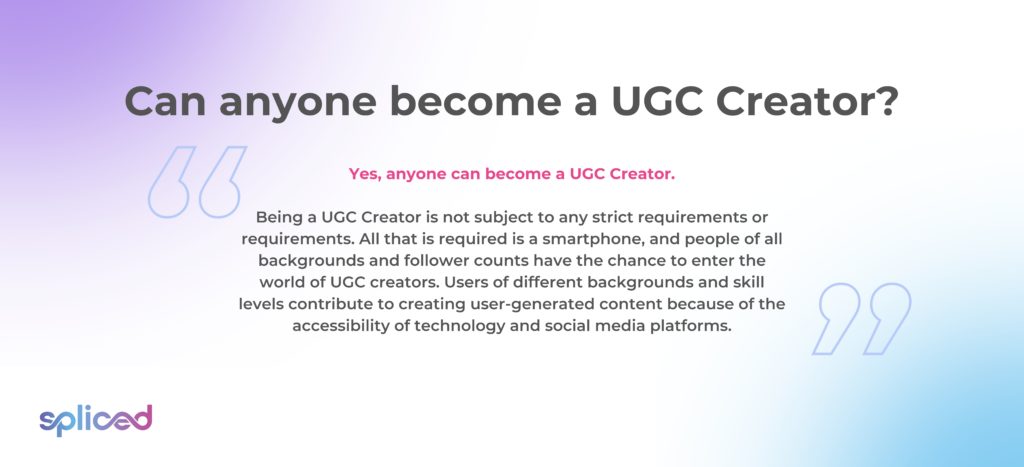
Can anyone become a UGC Creator?
Yes, anyone can become a UGC Creator. Being a UGC Creator is not subject to any strict requirements or requirements. All that is required is a smartphone, and people of all backgrounds and follower counts have the chance to enter the world of UGC creators. Users of different backgrounds and skill levels contribute to creating user-generated content because of the accessibility of technology and social media platforms. The only requirements are a desire to create content and a readiness to share it with a larger audience. The inclusiveness of UGC production is one of its main advantages. The phrase “UGC creators” refers to various content producers, emphasizing that elements like social standing or professional background do not constrain it. The openness means that almost anyone with a smartphone and a desire to be creative starts making UGC.
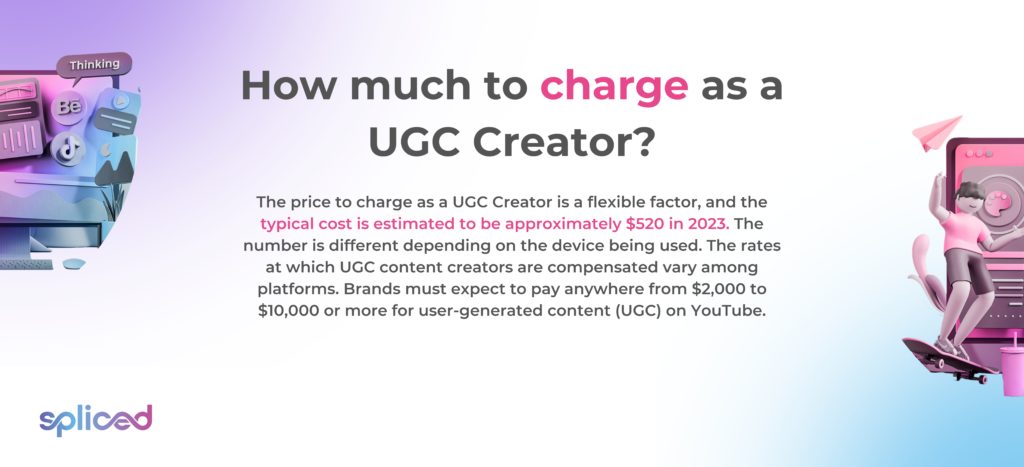
How much to charge as a UGC Creator?
The price to charge as a UGC Creator is a flexible factor, and the typical cost is estimated to be approximately $520 in 2024. The number is different depending on the device being used. The rates at which UGC content creators are compensated vary among platforms. Brands must expect to pay anywhere from $100 to $10,000 or more for user-generated content (UGC) on YouTube. The typical costs on Instagram and TikTok vary from $100 to $5,000 or more. UGC producers charge $200 to $2,000 for their material on social media sites like Facebook, Twitter, and Pinterest. UGC producers must be aware of the platform-specific pricing and consider aspects such as their own competence, reach, and the intricacy of the material when calculating their costs. They make sure they get fair compensation for their significant contributions to brand efforts in a manner.
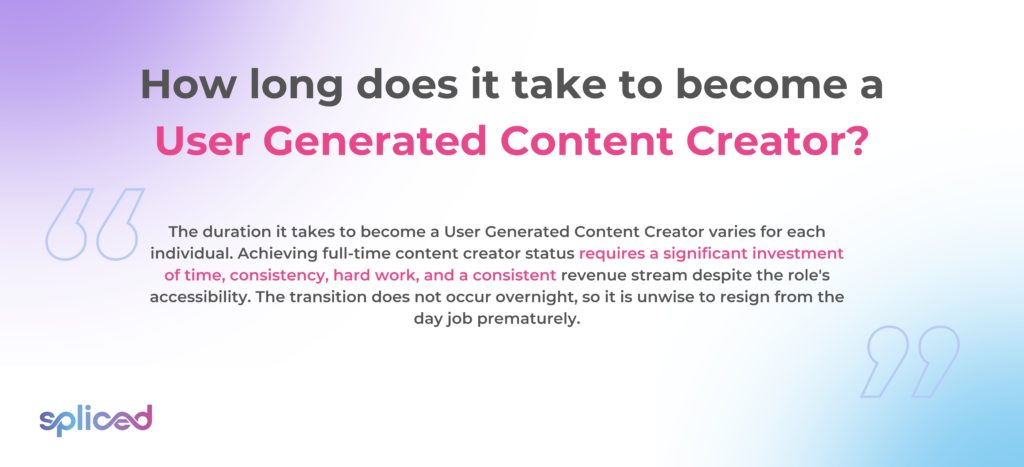
How long does it take to become a User Generated Content Creator?
The duration it takes to become a User Generated Content Creator varies for each individual. Achieving full-time content creator status requires a significant investment of time, consistency, hard work, and a consistent revenue stream despite the role’s accessibility. The transition does not occur overnight, so it is unwise to resign from the day job prematurely. A UGC Creator’s profession is built over time by developing their abilities, growing their following, and forming beneficial connections with companies. The path to becoming a successful user-generated content creator requires patience and perseverance.
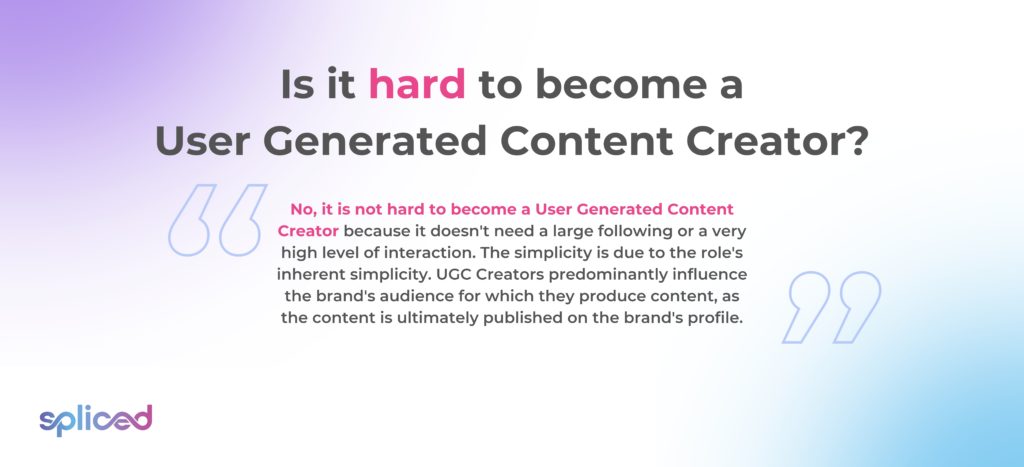
Is it hard to become a User Generated Content Creator?
No, it is not hard to become a User Generated Content Creator because it doesn’t need a large following or a very high level of interaction. The simplicity is due to the role’s inherent simplicity. UGC Creators predominantly influence the brand’s audience for which they produce content, as the content is ultimately published on the brand’s profile. It indicates that rather than depending exclusively on individual follower stats, the emphasis is on providing real and engaging content that appeals to the brand’s target demographic. Becoming a UGC Creator is available to a broader spectrum of individuals, regardless of their online presence.
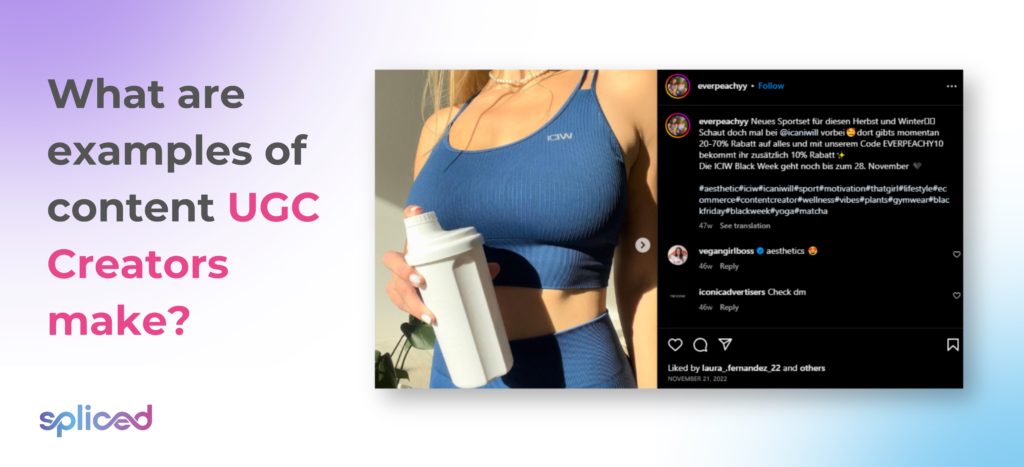
What are examples of content UGC Creators make?
The examples of content UGC Creators make are shown below.
Example #1
Example #2
Example #3
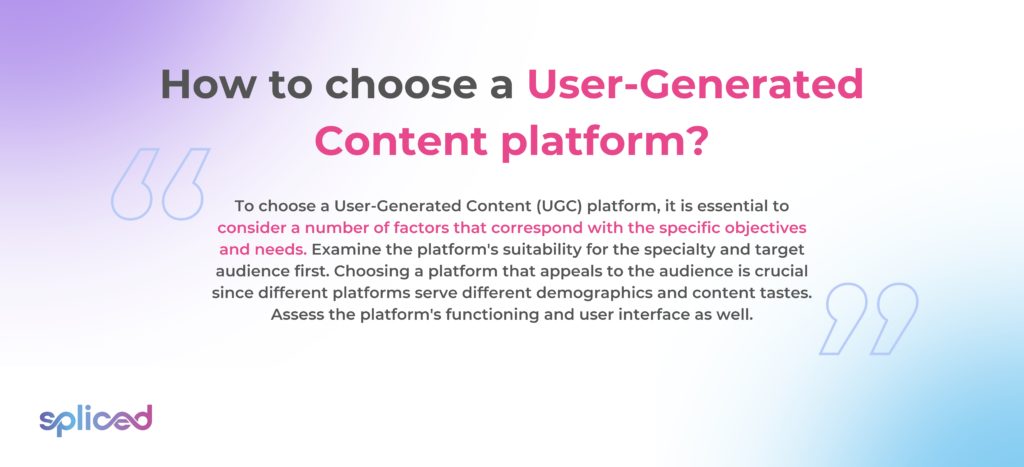
How to choose a User-Generated Content platform?
To choose a User-Generated Content (UGC) platform, it is essential to consider a number of factors that correspond with the specific objectives and needs. Examine the platform’s suitability for the specialty and target audience first. Choosing a platform that appeals to the audience is crucial since different platforms serve different demographics and content tastes. Assess the platform’s functioning and user interface as well. Viewers’ and contributors’ experience improved with an intuitive interface and features.
Search for systems that have strong moderating features as well. Ensuring that contributions comply with the brand’s rules and values is the result of effective content moderation. It is especially important to keep the community around the UGC efforts safe and happy. Consider the platform’s integration possibilities with the current systems and social media platforms. The process of gathering, selecting, and showcasing user-generated content across digital domains is made more efficient with seamless integration.
Think about the platform’s capacity for scaling and customization. Change and grow the UGC projects as the business grows. Assessing the success of user-generated content (UGC) initiatives requires the use of analytical tools that monitor interaction, reach, and performance indicators. The platform’s support and pricing policies must be considered. Check that it fits within the budget and offers the right amount of help via customer service or extensive documentation and resources. Choose a User-Generated Content platform that best fits the brand’s goals and target audience by carefully weighing these aspects.
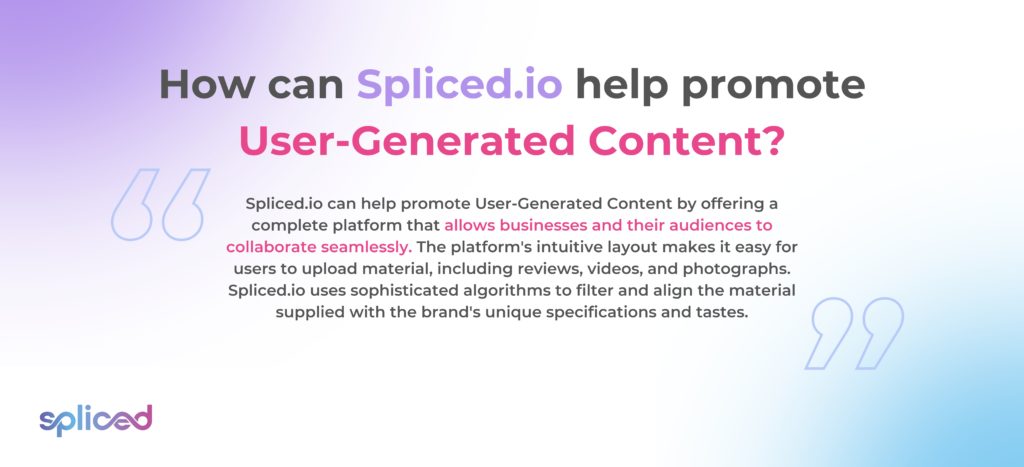
How can Spliced help promote User-Generated Content?
Spliced can help promote User-Generated Content by offering a complete platform that allows businesses and their audiences to collaborate seamlessly. The platform’s intuitive layout makes it easy for users to upload material, including reviews, videos, and photographs. Spliced.io uses sophisticated algorithms to filter and align the material supplied with the brand’s unique specifications and tastes. It guarantees that the brand’s message and values are fully reflected in the User-Generated Content.
Spliced.io provides robust moderating features, enabling marketers to keep control over the information that is released. It helps to preserve a favorable image and audience trust by ensuring that only material of high caliber and acceptable for the business is shown. The platform’s analytics and performance monitoring features provide insight into how User-Generated Content affects engagement, reach, and overall campaign success.
Spliced.io provides smooth integration with a brand’s current digital sites and social media platforms, which helps promote User-Generated Content even more. It allows marketers to extend their content’s reach across numerous channels, enhancing exposure and engagement. More methods for rewarding contributors are available on Spliced.io, including gamification elements and incentive systems, which entice more people to participate in the company’s content creation.
Spliced.io’s extensive feature set simplifies the process of gathering, selecting, and advertising User-Generated Content. Brands improve their marketing efforts, establish credibility, and create a thriving community around their goods and services by using the platform to capture the genuine voice of their audience.
Is TikTok a UGC Creator platform?
Yes, TikTok is a UGC Creator platform. TikTok UGC Creator content features items connected to a certain brand entirely created by consumers, not the businesses. The companies then use these pieces of content to advertise on different social media sites or to display on their official social media pages. The TikTok UGC Creator content is found in various formats, such as videos, photographs, testimonials, and more.
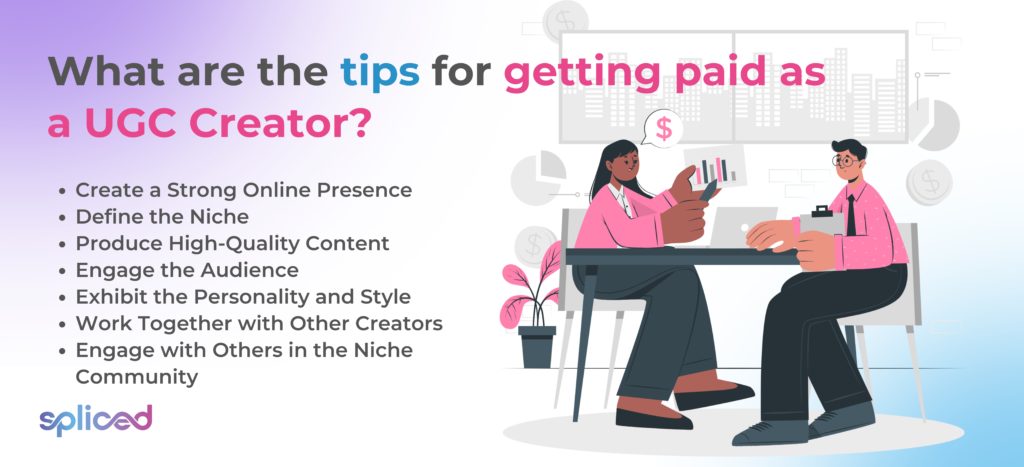
What are the tips for getting paid as a UGC Creator?
The tips for getting paid as a UGC Creator are listed below.
- Create a Strong Online Presence: Make an account on any site appropriate for the material, including TikTok, Instagram, YouTube, and Facebook. Consistency is key.
- Define the Niche: Concentrate on a specific niche or topic about which the creators are passionate and knowledgeable. It makes a committed audience more likely to be interested in the material.
- Produce High-Quality Content: Ensure the material is well-written, compelling, and appealing to the target audience. Quality content has a higher chance of becoming popular and attracting brand collaborations.
- Engage the Audience: React to feedback and messages and interact with the followers. Constructing a community around the content boosts credibility and marketability.
- Exhibit the Personality and Style: Allow individuality to emerge through the writing. Creators stand out from the crowd and get businesses’ attention as a result.
- Work Together with Other Creators: Working together helps creators reach a wider audience and improve exposure. It demonstrates to companies the openness to collaboration.
- Engage with Others in the Niche Community: Participate in debates, comment on pertinent topics, and interact with people in the specialized community. It aids in increasing the network and fostering new partnerships.
- Join Relevant Social Media Groups: Connecting with like-minded people and possible business partners is accomplished by joining groups or communities on websites like Facebook, Reddit, or Discord relevant to the expertise.
- Register with Platforms for Influencer Marketing: Signing up for influencer marketing networks helps creators connect with businesses searching for producers in the field. The negotiating process is often streamlined, and these platforms facilitate partnerships.
- Stay Authentic and Genuine: Maintain the authenticity. Avoid advertising items or services that are inconsistent with the brand or principles since it damages the audience’s trust.
- Know the Audience: Recognize the demographics of the target market. Brands aiming to target certain demographics find the information useful.
- Research and Brand Outreach: Find companies that are a good fit for the content and reach out to them with a persuasive proposal. Highlight the demographics of the audience, the level of participation, and any prior partnerships that were a success.
- Negotiate reasonably: Ensure that one gets paid reasonably for the time, effort, and audience reach when discussing money. Take into account elements like exclusivity, use rights, and advertising breadth.
- Observe Legal and Ethical Requirements: Become familiar with advertising laws and declare any sponsored material as needed by platform policy or legal requirements.
- Track and Analyze the Performance: Use analytics to see which material works the best and what the audience responds to. Future partnerships benefit from knowing the knowledge.
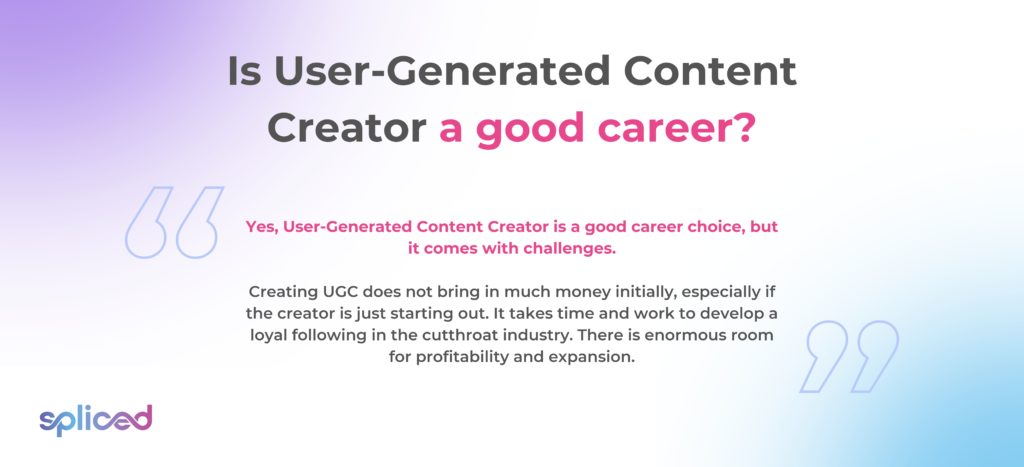
Is User-Generated Content Creator a good career?
Yes, User-Generated Content Creator is a good career choice, but it comes with challenges. Creating UGC does not bring in much money initially, especially if the creator is just starting out. It takes time and work to develop a loyal following in the cutthroat industry. There is enormous room for profitability and expansion. One way to get more valuable cooperation is to improve skills and show brands that the creator produces content that gets a lot of conversions. UGC creators often benefit from being genuine and personable, which connects with consumers deeply. Long-term financial success is achieved by leveraging authenticity for significant brand collaborations. A job in the field rewards persistence, originality, and the capacity to build sincere bonds with the audience. UGC Creator has the opportunity to transform their passion into a successful and rewarding career with commitment and smart preparation.
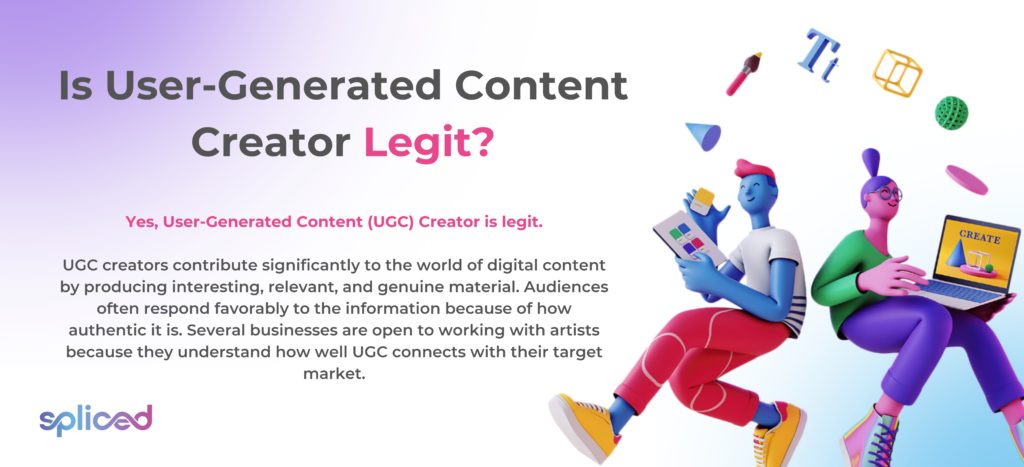
Is User-Generated Content Creator Legit?
Yes, User-Generated Content (UGC) Creator is legit. UGC creators contribute significantly to the world of digital content by producing interesting, relevant, and genuine material. Audiences often respond favorably to the information because of how authentic it is. Several businesses are open to working with artists because they understand how well UGC connects with their target market. It results in paid opportunities and collaborations. UGC Creators must adhere to legal and ethical standards, such as disclosing sponsored content and adhering to copyright laws. UGC Creators pursue a legal and perhaps profitable profession if they approach their job ethically and honestly.
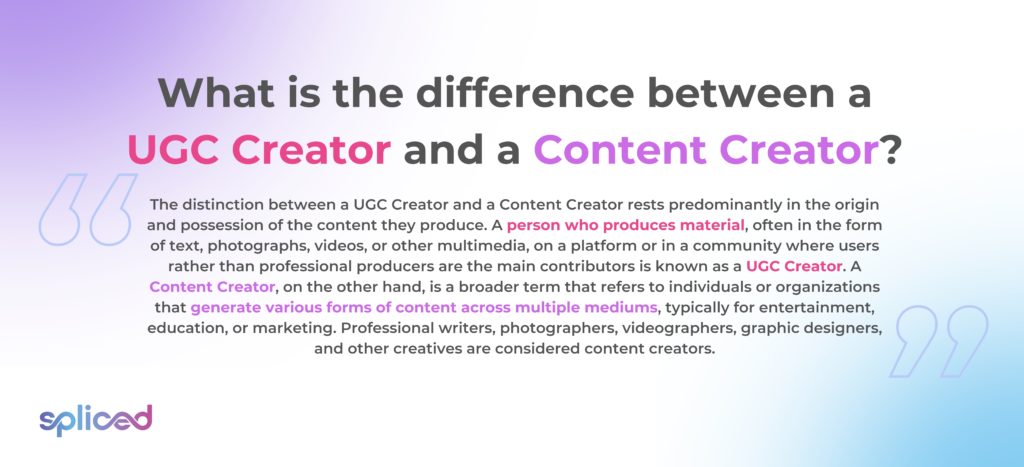
What is the difference between a UGC Creator and a Content Creator?
The distinction between a UGC Creator and a Content Creator rests predominantly in the origin and possession of the content they produce. A person who produces material, often in the form of text, photographs, videos, or other multimedia, on a platform or in a community where users rather than professional producers are the main contributors is known as a UGC Creator. The main purposes of the content’s creation are usually amusement, personal expression, or audience or community engagement. UGC Creators do not necessarily have professional training or expertise in content creation, but they play an essential role in the development and maintenance of online communities.
A Content Creator, on the other hand, is a broader term that refers to individuals or organizations that generate various forms of content across multiple mediums, typically for entertainment, education, or marketing. Professional writers, photographers, videographers, graphic designers, and other creatives are considered content creators. They produce material for a larger variety of platforms and purposes than UGC Creators do, including social media, blogs, YouTube channels, podcasts, and more. They are often recognized for their experience or talent in content creation. Ownership of the material is often retained by the content creators, who then monetize it in various ways, such as via sponsorships, ad income, or product sales.
The nature of the content and the environment in which it is created, in short, represent the primary differences. UGC Creators participate in particular user-driven platforms or communities, while material Creators create a wider variety of material across different media and often have a greater level of professional experience or talent in their respective disciplines.
